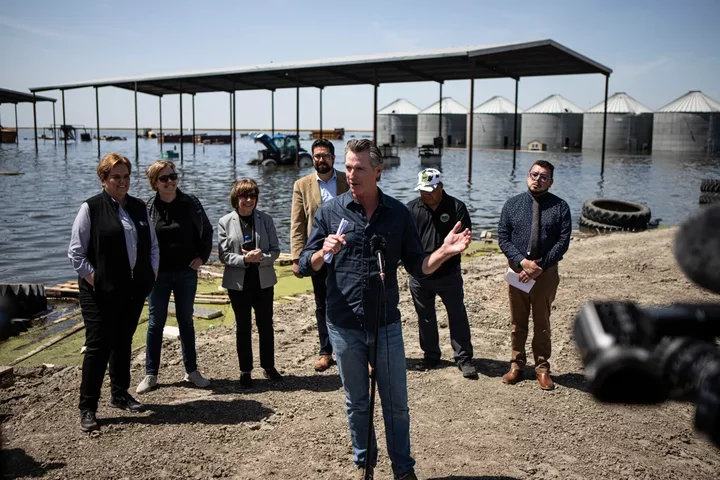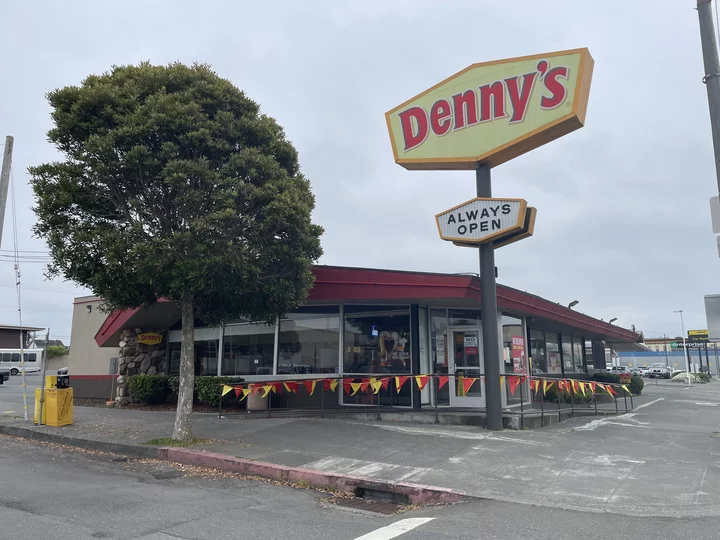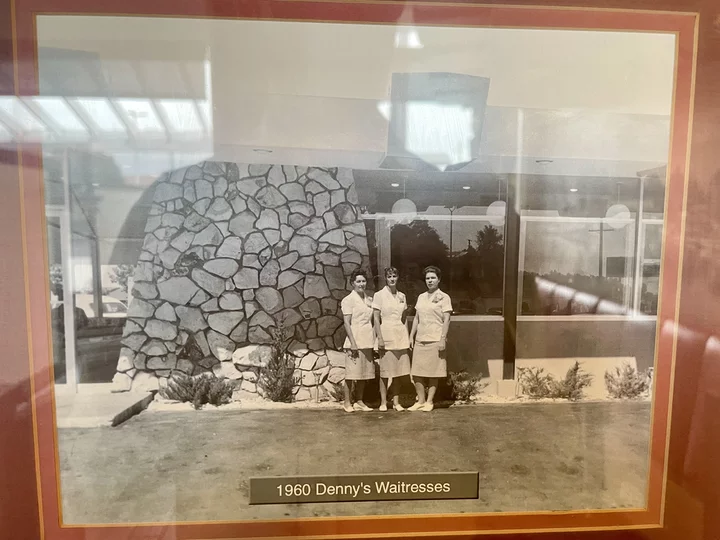HUMBOLDT TODAY with John Kennedy O’Connor | May 19, 2023
LoCO Staff / Friday, May 19, 2023 @ 4:46 p.m. / Humboldt Today
Your daily news video roundup! Press play above, scroll down for additional reading.
Also: Who makes the best pizza in Humboldt County? Scroll down farther to vote in the Pointless Poll, where we settle this once and for all.
ADDITIONAL READING:
- After 50 Years in Eureka, Humboldt County’s Last Denny’s Will Close May 31, Soon to be Replaced by an IHOP
- Finally Released From Hospital, Second Suspect in April Police Shootout in Eureka Arrested, Charged With Attempted Murder of Officer
- NEW TSUNAMI MAPS! Revised Maps of Potential Danger Show Less of Humboldt Being Swept Away Than Previously Feared
BOOKED
Today: 7 felonies, 9 misdemeanors, 0 infractions
JUDGED
Humboldt County Superior Court Calendar: Today
CHP REPORTS
Us101 N / Benbow Ofr (HM office): Live or Dead Animal
2654-2703 Harris St (HM office): Trfc Collision-No Inj
5500 Mm101 N Men 55.00 (HM office): Assist with Construction
ELSEWHERE
RHBB: Ishi Pishi Road Closed October 14-20 for Culvert Replacements
RHBB: Voyage to the Galápagos Explores How Ocean Nutrients Sustain Life
RHBB: ‘Be Prepared for the Rain, Protect the Storm Drain!’ — City of Arcata
Gavin Newsom Wants to Make It Easier to Build Roads, Dams and More. What’s in His Plan?
CalMatters staff / Friday, May 19, 2023 @ 3:11 p.m. / Sacramento
Gov. Gavin Newsom speaks to the media in a press conference at Hansen Ranches outside of Corcoran on April 25, 2023. Newsom addressed the areas flooded farmlands during the winter storms in Kings County. Photo by Larry Valenzuela, CalMatters/CatchLight Local.
Gov. Gavin Newsom wants to make it easier for California to build big things. On Friday, he unveiled a plan to make it happen.
At an 1,100 acre solar farm near Patterson in Stanislaus County, Newsom announced a package of legislation and signed an executive order aimed at speeding big infrastructure projects and limiting the time that opponents can jam them up in court.
Buoyed by an influx of federal dollars and motivated by the need to dramatically reduce the state’s greenhouse gas emissions, Newsom’s proposal is likely to be cheered by industry groups, construction unions and even some climate activists.
Newsom said the plan was about more than the urgency of climate change, but about rebuilding the public’s faith in the state’s ability to commit to and accomplish big things.
“As someone who’s all in on high-speed rail…all I can think about is, ‘what if?’ ‘What if we had these principles before we laid out that project?’” he said, referring to the $128 billion, much-delayed rail project. “I may not have had to drive down here today. I may have been on that rail.”
California isn’t short on what the governor might call “big hairy audacious goals.” The state has a plan to harvest all of the state’s electricity from carbon-free sources by 2045. Newsom administration adopted a plan to phase out the sale of gas-guzzling cars, shifting the state’s appetite for driving onto the electricity grid. Proposed projects on water — to store it, to strip it of saltwater, to keep it at bay as sea levels rise and rivers top their banks — abound.
To meet those goals, California needs to build, potentially at a scale that would dwarf even the boom times of the 1960s. At a breakfast gathering of big business representatives in Sacramento on Thursday, the governor stressed that the state is ready to spend $180 billion over the next 10 years, much of that money coming from the federal government.
“The question is, are we going to screw it up by being consumed by paralysis and process?” Newsom asked.
Have questions about Newsom’s big proposal? Here’s what we know.
Q: What is Gavin Newsom actually proposing?
A: Details are still sparse, but the governor’s executive order, a summary of 11 bills released by his office, a separate report put out by administration infrastructure adviser Antonio Villaraigosa and Newsom’s remarks speak to the following goals:
- Streamline environmental planning by coordinating among different local, state and federal agencies;
- Limit the amount of time courts have to weigh environmental challenges to nine months;
- Provide more funding to agencies that speed up reviews;
- Cut back on the number of documents that each review requires;
- Carve out more exemptions in the law to allow favored projects to skip certain environmental reviews.
Some of these changes would broaden provisions already included in state law.
The nine-month limit on environmental litigation, for example, already applies to renewable energy projects, certain housing and even major sports stadiums.
“I love sports,” Newsom said. “But I also love roads. I love transit. I love bridges…why the hell can’t we translate that to all these other projects?”
Q: Is Newsom CEQA reform plan a big deal?
A: To hear Newsom say it, this is a very big deal.
“If we get nothing else done in the next three years, this may be one of the most consequential things that we can actually deliver,” he said on Thursday.
For decades, California’s deliberate — or as critics argue, glacially slow and unpredictable — permitting process has been a hallmark of its environmental policy. At the heart of that process is the California Environmental Quality Act.
California lawmakers passed the law in 1970, riding a new public consciousness of environmental conservation and protection. It was a bipartisan sentiment. The governor who signed the law was Ronald Reagan while President Richard Nixon signed its federal counterpart that same year.
At the time, the chief environmental concerns were local and growth-related: The incursion of development into green spaces and sensitive ecosystems; the widespread use of pesticides; the pollution of rivers and the befouling of oceans; littering.
Business interests have decried “CEQA abuse” for decades. Now that climate change is the chief environmental concern of the day, some liberals are on board with “permitting reform” bandwagon, too. They argue the state needs to build at an unprecedented scale to decarbonize its electricity grid and transportation networks.
Jennifer Hernandez, a land use and environmental attorney in San Francisco, said she was cautiously optimistic that the changes the governor spoke about would speed litigation.
In particular, the governor’s comments regarding addressing what constitutes an administrative record under the environmental law, could go far, she said.
When a civil lawsuit is filed under the environmental law, the first thing that occurs is preparation that can take months to more than a year to gather. That’s because the administrative record is broadly defined, she said. It can include emails, text messages by officials and other pieces of information that may not strictly pertain to the environmental impact of a project, she added.
“The administrative record was defined about 20 years ago, to include internal agency communications, even emails about whether you want pizza for the meeting,” Hernandez said.
When Hernandez spoke, however, she had yet to see anything concrete about the governors’ specific proposals.
“I’m eager to see the actual bill language,” she said.
Q: What types of projects will be affected?
A: In the executive order, Newsom called out a few spending areas specifically: “transportation, energy, hydrogen, environmental remediation, broadband, water, the CHIPS and Science Act (for semiconductor development), and zero-emission vehicles.”
Newsom named two major water proposals as examples of the kinds of projects that could benefit from the package: the Sites Reservoir in the Sacramento Valley and a tunnel that would funnel water under the Sacramento-San Joaquin Delta.
Osha Meserve, an attorney in Sacramento who has represented opponents of the tunnel, said rigorous environmental review is justified when it comes to projects like the tunnel, which has been the focus of disagreement and legal challenges for decades.
“If you’re going to go across four counties and build the largest new infrastructure project in the whole state, then yes, you’re going to need some detailed environmental reviews,” Meserve said.
Jerry Brown, the executive director of the Sites Project Authority (and not the former governor of the same name), said the governor’s action could advance the process of acquiring a water right for the proposed Sacramento Valley reservoir by about six months.
“That means we get into construction sooner, means we finish construction sooner,” he said “We’re talking about a project here where a year delay costs about $100 million.”
Q: What about housing?
A: Newsom didn’t mention housing prominently at his press conference.
His administration is urging local governments to permit more than 2.5 million new units over the next eight years. Among pro-housing advocates, the environmental law is often cited as an unwelcome impediment — both because opponents can sue and delay projects and because the mere prospect of a lengthy legal battle can result in fewer and smaller housing projects being proposed.
When asked about housing by a reporter, Newsom noted that some of the broad changes to permitting and record-keeping policy will speed up the construction of new homes, along with everything else.
Q: Will the plan harm the environment?
A: Not if you ask the governor, it goes without saying.
“I care deeply about what the environmental community believes and thinks, but at the same time I care deeply about the progress we’re promoting here today,” he said today.
Newsom had some backing from at least one major green group: Environment California, a nonprofit that often stakes out a centrist position on climate-related policy.
“We need to work harder, better, faster, stronger to build five times as much clean energy every year,” the group’s director Laura Deehan said at today’s press conference.
But it’s not clear whether the state’s broader environmental community will be as enthused.
Barbara Barrigan-Parrilla, the executive director of the group Restore the Delta, lashed out at the governor following the release of his order.
“We have never been more disappointed in a California governor than we are with Governor Newsom,” she said in a statement.
Q: What are the odds this goes anywhere?
A: It’s too early to tell.
The governor’s office has yet to release any legislative text. Neither of the offices of Assembly Speaker Anthony Rendon nor Senate leader Toni Atkins responded when asked for comment.
The current law has its defenders. Chief among them are environmentalists and environmental justice advocates who see it as a vital tool to check unfettered development and pollution.
Also among CEQA’s supporters: Neighborhood groups who often use the law to stymie big, noisy projects in their backyard and organized labor groups, who have found it to be a useful way to block projects in order to extract union-friendly concessions and.
Newsom appears to have at least part of that latter group in his camp. At Friday’s press conference, the governor was flanked by hardhat wearing carpenters, laborers and electricians. Among the biggest applause lines: The projection, unverified, that this proposal will lead to the creation of 400,000 new jobs.
###
This report was written and reported by Ben Christopher, Alastair Bland, Julie Cart and Alejandro Lazo. CalMatters.org is a nonprofit, nonpartisan media venture explaining California policies and politics.
Humboldt Association of Realtors Announces Plans to Take Over Redwood Curtain Theatre Building in June
Stephanie McGeary / Friday, May 19, 2023 @ 2:38 p.m. / Business
Come this June this building will no longer hold local plays and instead will hold the Humboldt Association of Realtors’ offices | Stephanie McGeary
PREVIOUSLY:
###
The Outpost reported a couple of months ago that Redwood Curtain Theatre would be leaving its longtime home at 220 First Street in Eureka, after the previous owner decided to sell the space to an unknown buyer. And since then, you may have been wondering what exciting new thing would be going into the building.
Well, wonder no more! Because today LoCO learned that the space is being taken over by (drumroll, please) … the Humboldt Association of Realtors, to be used as the company’s new office space.
“HAR has found a new home!!!” the organization posted in its newsletter, which came out on May 15. “The Humboldt Association of Realtors Board of Directors are very excited to announce that our Facility Committee has been hard at work and has found a new location for the HAR office! We are in escrow and plan to take over our new building June 30, 2023. The address is 220 1st St, Eureka, CA 95501.”
The newsletter goes on to say that the space will be undergoing a remodel, which could take up to a year, so HAR won’t be able to move in right away. But the board seems thrilled for what will likely be a bit of an upgrade from HAR’s current office space at 527 W. Wabash.
And if it’s not exciting to you that the building that held a small, community theater for more than 15 years will become a space for supporting the real estate industry, then perhaps you will have more interest in HAR’s old space going up for sale, which the letter says will be listed in June.
“If you have any viable buyers, please let us know!” the letter says. “The HAR staff will temporarily relocate to an interim work space while we work to remodel the new facility.”
After 50 Years in Eureka, Humboldt County’s Last Denny’s Will Close May 31, Soon to be Replaced by an IHOP
Ryan Burns / Friday, May 19, 2023 @ 2:14 p.m. / Business
The Denny’s restaurant on the corner of Fifth and C streets. | Photos by Ryan Burns.
###
The sign out front says “ALWAYS OPEN,” but all things must end. After half a century on the corner of Fifth and C streets in Eureka, the last remaining Denny’s in Humboldt County will permanently close at the end of the month.
Owners Safar and Lori Ghaffari say they’re ready to retire, and after failing to find another Denny’s franchisee willing to take over the location, they found a couple who intends to lease and renovate the restaurant, turning it into another popular restaurant chain known for its American-style breakfasts: IHOP.
“I look at the hospitality business as a big book: one chapter closes, another chapter opens,” Safar Ghaffari said.
I spoke to him and his wife this morning on speakerphone as I sat in a booth-style bench seat at the far end of the dining room. Above the bench was a framed, mural-sized photo of the Woodley Island Marina. Superimposed on the photo was the iconic yellow and red Denny’s sign impaled atop a giant fork above the words, “Good Food, Good Friends, Good Times.”
Before sitting down for this phone interview I’d spoken with the manager on duty, a shift supervisor named Kelley. (Both the workers on duty and the Ghaffaris agreed that it would probably be best not to publish any of the employees’ last names since they’ve had to 86 a few rough customers over the years.)
Kelley has worked at this Denny’s for 31 years. She and her 22 coworkers learned of the pending closure at an employee meeting on Wednesday, which means they each got two weeks’ notice about their pending unemployment.
“I’m hoping that the IHOP people will hire us,” Kelley said. “That’s what we’re all hoping for.”
Safar Ghaffari said he tried to reassure his employees that they had nothing to worry about on that front.
“I said, ‘Are you crazy? Of course you’re gonna have a job. It’s your choice whether you can stay a few weeks.’” He feels confident that the new IHOP managers, who will lease the building from the Ghaffaris, will be eager to hire everyone who’s currently on staff.
”I would estimate that they’re all going to [be hired] as long as they stay during the transition, because it takes time to change to a new brand,” he said. He estimates that the building will be closed for four to six weeks while the place is remodeled and converted into an IHOP.
His wife chimed in with a bit of history, saying this Denny’s has been around since the early 1960s — ‘63 or ‘64, she figures, though there’s a framed photo inside bearing the label “1960 Denny’s Waitresses.” It shows three stern-looking women standing outside the Eureka restaurant, next to one of the chain’s characteristic walls of rough-hewn stone.
“It’s always been a really popular spot,” Lori Ghaffari said. “And I really appreciate our team that has been dedicated to serving the community and people that are coming through our area for the redwoods and that sort of thing. You know, they’re really the backbone of any public serving industry. They’re really Denny’s. We really appreciate our staff. They’ve been great.”
Her husband agreed, saying the employees are “just like our extended family, basically. I’m hoping they all choose to stay within the new [franchisee] because that individual needs them real bad, no doubt.”
The Ghaffaris took over the Eureka Denny’s in 2000, seven years after opening a Denny’s in Fortuna, which Safar Ghaffari said was his first business.
“And I built that one, too,” he said. “I built a lot of locations on the West Coast.”
His career with Denny’s began where most new employees start: washing dishes. “Halloween night in 1975,” he recalled. He still remembers the address: 1776 Powell Street in Emeryville, Calif. That year would turn out to be a momentous one for Safar. He met Lori on Cinco de Mayo, started working at Denny’s on Halloween and married Lori on December 3.
“It all happened in 1975; the rest is history,” he said.
He wound up working on the corporate side of Denny’s for about 14 years, working at Denny’s in the Bay Area and Sacramento. After building the Fortuna Denny’s and taking over the Eureka one, the Ghaffaris opened a location in McKinleyville, but in anticipation of their pending retirement they shut it down on December 28. It’s slated to become a Mountain Mike’s Pizza.
They sold the one in Fortuna to a former business partner years ago. It closed unceremoniously in 2009.
Another historic photo of the Eureka Denny’s that hangs on the wall inside the restaurant.
Kelley, the shift manager, said the new IHOP managers hired someone who came in recently to take measurements for the pending conversion.
“It’s been up for sale for quite a while,” she said.
As we talked, Kelley’s coworkers went back and forth from the kitchen to the dining area, where people sat sipping coffee and pushing forks through soft, syrupy pancakes, possibly consuming the chain’s signature dish: the Grand Slam breakfast.
The Ghaffaris were cheerful throughout our conversation. Safar said the new operators are in the process of selecting a contractor for the renovations and getting the necessary permits from the city. He said he’d like to keep things on a positive note, and he hopes people will welcome the “new concept” of an IHOP.
“It’s still bacon and eggs,” he said. “Still Kelley’s gonna take care of [customers], and hopefully the restaurant can stay.”
Before hanging up he offered well-wished: “Have a Grand Slam day!”
One last note:
Earlier this week, after learning about the sudden (though temporary) closure of the Samoa Cookhouse (whose employees were reportedly laid off without any advance notice), the Outpost reached out to the Humboldt County Office of Economic Development to learn what resources are available for people who suddenly find themselves out of work.
Economic Development Director Scott Adair forwarded a fact sheet from the state’s Employment Development Department listing rapid response resources for employers and laid off workers. (Click here to download a copy.)
The county has its own layoff aversion and rapid response programs, offering no-cost resources to businesses and workers in the event of a business closure or planned “layoff event.” More information can be found here.
NEW TSUNAMI MAPS! Revised Maps of Potential Danger Show Less of Humboldt Being Swept Away Than Previously Feared
Hank Sims / Friday, May 19, 2023 @ 11:12 a.m. / Emergencies
Yesterday, the Outpost was alerted to the fact that the powers that be have revised the iconic tsunami zone maps that we coast-dwellers have seared into memory.
According to Ryan Aylward, who stopped by the Outpost offices yesterday with brochures in hand, work on the revised maps began around 2020, and involved both high-detail LIDAR work and historical core samples to determine the outer boundaries of where the seas might rise when The Big One strikes.
The good news for Humboldt is that a great deal of land that was thought to be in the tsunami zone is no longer considered to be in danger. For instance: There are now places around the town of Fairhaven that can serve as safe evacuation sites, when that previously was not thought to be the case.
That’s not the case everywhere in Humboldt, but a glance at the map shows that we’ve been able to reclaim a bunch of land from the tsunami zone. A bunch of the Arcata Bottoms, for instance, is now in the safe zone — denoted in green, on the new maps — when it used to be in the dangerous “yellow zone. “
Up in Del Norte, Aylward said, the case is altered. A lot more territory is riskier than had been understood, previously.
Remember: What’s depicted on these maps are worst-case inundation scenarios, and that worst case is a major Cascadia Subduction Zone slip, which has in the past and will in the future result in earthquakes in the neighborhood of a magnitude 9. When that happens a tsunami is guaranteed, and you have minutes to get to high ground.
So you’ll want to know where safe territory is well in advance. Find below the new, revised maps, and reacquaint yourself with the status of the special places on your daily routine. If that’s not working for whatever reason, you can find a direct link here. You can also find handy printable detail maps for at-risk communities in Humboldt, Mendocino and Del Norte counties at the Redwood Coast Tsunami Work Group.
Finally Released From Hospital, Second Suspect in April Police Shootout in Eureka Arrested, Charged With Attempted Murder of Officer
LoCO Staff / Friday, May 19, 2023 @ 10:36 a.m. / Crime
PREVIOUSLY:
- (LIVE) Sheriff’s Office Press Conference About Yesterday’s Police Shooting on Harris Avenue
- Sheriff’s Office Issues Statement on Harris Street Incident, With Clear Photos of the Suspects and Weapons Recovered
- Eureka Police Officially Arrest One Suspect in April Assault, Police Chase That Resulted in Harris Street Shootout
Press release from the City of Eureka:
On May 18, 2023, Brandon Michael Widmark was arrested and booked into the Humboldt County Correctional Facility. This arrest resulted from his involvement in the April 18th critical incident that occurred at the intersection of Harris and Dolbeer Streets in Eureka. Brandon Widmark was arrested for the following charges:
Attempted Murder of a Peace Officer, Brandishing a Firearm in the Presence of a Peace Officer, Felony Obstruct/Resist a Peace Officer, Robbery, Assault with a Deadly Weapon Other than a Firearm, Child Endangerment, Felony Hit and Run, Evading Causing Great Bodily Injury and for being a Felon in Possession of a Firearm.
Why the ‘Science of Reading’ May Be the Next Dyslexia Battleground
Joe Hong / Friday, May 19, 2023 @ 7:45 a.m. / Sacramento
Books about dyslexia at a home in Clayton on Jan 29, 2023. Photo by Shelby Knowles for CalMatters
State lawmakers plan to require that all students be tested for dyslexia and other reading challenges, but the hurdles ahead point to a bigger problem with how California’s public schools teach reading.
Before teachers can screen their students, they themselves need to be trained both in how to use the screening tests and how to help the students who get identified as struggling readers. Many experts and educators say most public school teachers in California weren’t adequately trained to teach students how to read.
“Nobody goes into teaching to mess up a kid’s life,” said Leslie Zoroya, a teacher coach specializing in literacy at the Los Angeles County Office of Education. “Teachers do think they’re teaching kids to read. But when you look at the data, it’s telling us that is not the case.”
Across the state, only about 42% of third-graders met or exceeded English language arts standards last year.
“Teachers do think they’re teaching kids to read. But when you look at the data, it’s telling us that is not the case.”
— Leslie Zoroya, teacher coach specializing in literacy at the Los Angeles County Office of Education
The mandatory dyslexia screening policy was a part of Gov. Gavin Newsom’s revised budget proposal released last week, which allocated $1 million to form a panel of experts who would compile a list of reliable screening tools as well as determine the types of training needed for teachers. The proposal seeks to screen all students between kindergarten and second grade starting in the 2025-26 school year.
The policy proposal comes after several legislative efforts, spanning multiple years, to require dyslexia screening in California’s public schools. They failed largely due to opposition from the California Teachers Association. The statewide teachers union argued the practice of screening all students would disproportionately push English learners into special education and said the legislation needs to provide more resources for teachers.
The union did not respond to questions for this story about the types of support and training teachers need. But for some experts, the fact that teachers even need training to help students who struggle with reading illustrates just how far behind California is in literacy instruction.
“We’re going to need a lot more training,” Zoroya said. “This needs to be a statewide effort.”
The problem is twofold, according to experts. First, most of California’s public school districts use reading curricula based on “balanced literacy,” an approach to reading instruction based on the idea that children are natural readers. It relies on exposure to books and the enjoyment of reading with less of an emphasis on sounding out words. Second, the experts say, teacher preparation programs don’t train teachers enough in “structured literacy” or “the science of reading,” which focuses heavily on phonemic awareness and phonics — the practice of matching letters to sounds and sounding out words.
Betina Hsieh, the chair of the teacher education program at Cal State Long Beach, said balanced literacy curricula do include some phonics and argued that the balanced literacy approach works for most students.
“No one is saying that phonics and phonemic awareness is not important,” she said. “The thing is, it only gets you so far.”
But Hsieh agrees that all younger students should be screened for dyslexia and reading challenges and that teachers need to be trained. But she expressed frustration that there’s already so much material squeezed into teacher credentialing programs.
Zoroya argues that if teachers had been better trained in phonics instruction, dyslexia screeners would be a natural extension of their instruction. Because screeners test students’ ability to pair letters to sounds, a teacher who is adept in phonics will have an easier time navigating not just screening but helping students overcome their reading challenges.
“This work is too important for adults to be out here arguing,” she said. “We have too many kids coming out of elementary school not being able to read well.”
Too little phonics
Zoroya, who trains teachers across the 80 school districts in Los Angeles County, said most elementary school teachers don’t know how to teach reading through “structured literacy.” The approach’s focus on phonics enables students to sound out unfamiliar words.
Across California, students typically learn reading by being exposed to text and being read to in the classroom. Teachers focus on cultivating a love of reading as opposed to a more systematic instruction in letter sounds. While most students are able to learn reading through the former method, many are left behind. Dyslexia, a neurological condition that causes difficulty reading, affects about 1 in 5 people across the country.
According to experts, the fact that California is one of 10 states that doesn’t screen all students for dyslexia is a symptom of the broader problem of how public schools in the state teach reading. For educators, reading instruction remains hotly debated.
“It reminds me a bit of politics right now,” Zoroya said. “Even reading is very polarized.”
The debates over reading instruction have a deep and contentious history, which some refer to as “the reading wars.” In California, the “balanced literacy” approach came out on top in the reading wars. But teachers and parents across the country have spoken out against it, calling it a well-intentioned but fundamentally misguided way to teach reading.
Santiago Cuevas, a first grade teacher at San Francisco Unified’s Lafayette Elementary, said he received hardly any training in phonics instruction while earning his credential at San Francisco State University. He had to study the concepts of the “science of reading” on his own to pass the Reading Instruction Competence Assessment, one of the requirements for a teaching credential. The assessment tests prospective teachers’ ability to develop a reading curriculum, ranging from phonics to reading comprehension.
Cuevas said he was lucky to get hired at a school that happened to be committed to teaching phonics. But for most other teachers, the material they studied to pass the reading instruction assessment becomes an afterthought because their districts use balanced literacy.
“The RICA is just one of the things on the checklist to becoming a teacher,” Cuevas said. “It’s kind of strange how we didn’t talk about the science of reading at all at SF State.”
“In some ways, it feels very comfortable to primary grade teachers who say their students will catch up later. So it can be very uncomfortable when we put a universal screening measure in place.”
— Margaret Goldberg, literacy coach in West Contra Costa Unified
Margaret Goldberg, a literacy coach in West Contra Costa Unified, said not only are most teachers using faulty curricula, they’re also not assessing their students enough between kindergarten and second grade. Statewide literacy data is only available starting in third grade. But because students show signs of reading challenges as early as kindergarten, teachers need to take reading instruction seriously as early as age 5, she said.
“In some ways, it feels very comfortable to primary grade teachers who say their students will catch up later,” Goldberg said. “So it can be very uncomfortable when we put a universal screening measure in place.”
That discomfort materialized in the fight to mandate screening for dyslexia in California. The California Teachers Association, the state’s largest teachers union, opposed the proposed policy for multiple years despite a chorus of literacy experts calling for early screening for all students. The union said the legislation lacked details around what types of training teachers would need and how often students should be screened.
Cuevas said teachers who are more comfortable with phonics and the science of reading will be much more comfortable screening students.
He said, for example, if a student had a hard time saying the word “chair,” the balanced literacy approach would recommend just giving that child more books about chairs. But a teacher with training in structured literacy and phonics instruction has a more systematic approach that includes more testing and targeted instruction.
“It just seems like everyone’s trying to kick the can down the road,” Cuevas said. “With the science of reading, you just think differently.”
A necessary change
Goldberg and Cuevas agree that teachers, even those supportive of balanced literacy, have the best intentions. But they said that the shift toward mandatory screening should be accompanied by a shift toward more phonics instruction.
Goldberg said teachers first need to understand why screening matters. She said teachers typically see assessments as punitive and burdensome, but tests used to detect dyslexia and other reading challenges are a tool for improving instruction. Teachers might not understand why the tests ask students to sound out nonsense words, but Goldberg said sounding out random clusters of letters is the best way to detect whether a student will struggle with reading.
“They seem like arbitrary tasks,” she said. “Once you understand why each measure is important, administering the screeners is actually quite simple.”
School and district administrators also need to embrace these shifts. Meghan Trutter, a reading intervention specialist in the San Jose area, said teachers who learn about the science of reading later in their careers often tell her “this is what I needed all along.”
But Trutter said she’s concerned about whether districts will support teachers with the right curricula once the state mandates screening. If teachers aren’t given the necessary textbooks and materials to teach phonics, screening will be a pointless exercise.
“If the district executives don’t get it, they’re going to be another roadblock,” she said. “I can see teachers saying ‘We’ve identified the problems, now what?’ The district might say ‘I don’t know.’”
However, educators say there’s some much needed changes coming to teacher credentialing programs. A law signed in 2021 requires programs to teach the science of reading approach by 2025.
“I believe new teachers that are coming out of these programs are going to be better equipped to teach students how to read,” said Mara Smith, a reading specialist with the L.A. County Office of Education who helped revise California’s standards for teacher credentialing.
Long-term obstacles
The overhaul necessary in higher education will be easier said than done, according to some professors. Hsieh, at Cal State Long Beach, said one issue is the segregation of special education and general education programs.
She said prospective teachers in general education programs don’t get the training they need in phonics because those skills are more intensely taught in special education programs that focus on working with struggling students.
Another problem is the short length of teacher training programs. Elementary and middle school teachers earn the same multiple-subject credential. Their training spans instruction for kindergarten through eighth grade. Hsieh says this leaves little wiggle room for changes to teacher-training curricula.
“We’re working on being flexible and adaptive, but it’s challenging,” she said. “There’s so much that’s being demanded of teachers.”
And it’s not just classroom teachers and district administrators who are entrenched in balanced literacy. Most professors teaching in California’s credentialing programs are also committed to the approach, according to Kathy Futterman, a professor at Cal State East Bay. She said most professors aren’t sufficiently trained in structured literacy.
“I don’t know how many professors and instructors have themselves mastered structured literacy,” she said. “I feel like I’ve been swimming upstream and swimming solo for a long time.”
Futterman said the push for structured literacy as well as for mandatory screening started as a grassroots movement among parents and classroom teachers. But without a more systemic transformation, reading instruction in California will remain a patchwork, she said.
“We are heading in the right direction,” Futterman said. “Now we have to make sure everybody can be on board.”
###
CalMatters.org is a nonprofit, nonpartisan media venture explaining California policies and politics.










